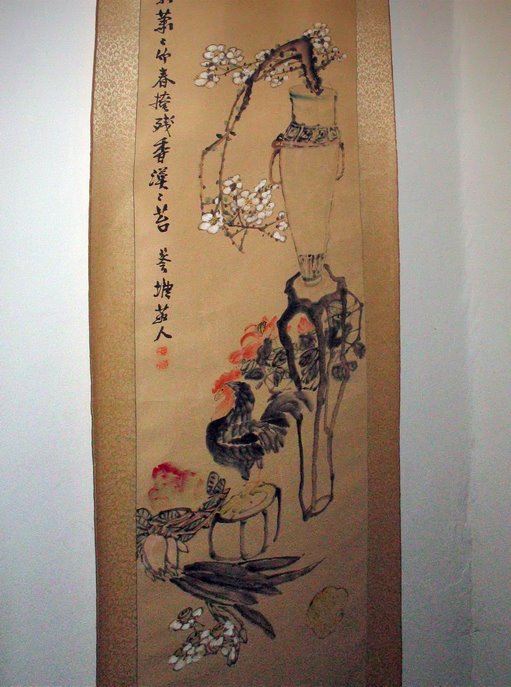
The antique shopping trip to Canonsburg was on a warm winter Sunday afternoon. We’ve stopped at almost every antique store there and decided to finish the last one which was in the same block with the other two we’d just visited. The scale of antique stores in Canonsburg outweighs the size of the town because “it is cheaper to open a store here.”
The store looked tasteless with a special bargain room open on Sunday. The owner, a typical suburban American woman in her middle age greeted us from her chair surrounded by all different stuff.
It almost turned out to be another futile excursion (we hadn’t got anything except tired legs) before I spotted a Chinese paining of plum.
It was damaged: The right corner of the scroll was broken and that was the first thing I noticed. Being an impatient non-serious antique shopper, I usually only show my interest in those “intact”. But after Eric joined me, I was attracted by the poem:
I didn’t know who wrote the poem and I was not sure whether I read it correctly from the handwriting. Actually even worse, I haven’t read any poem or book in Chinese since I came to US. But the subtlety and delicacy of the Chinese words brought out my memory of the happy time spent in reading poems of Tang Dynasty. Those words by being seen and being pronounced, suddenly became magic and I even thought I could smell the subdued fragrance from plum.
“It was a 1950’s work and that’s all I know about it.” The owner told me. Then I volunteered to translate the poem into English, which I definitely don’t have the skill but luckily am better than anyone else in the room.
“Winter accompanies your lonely shadow echoing the shuddering bamboos, spring tries in vain to hide the remains of your light fragrant.”
After carefully examining the scroll, I noticed that there was some note written on the back of the bottom scroll. It read “To Du Mei at the 1960’s QingBei Medical School’s class reunion party on April 7, 1975”. Well, it was not a 1950’s work, but definitely older than I!
The painting features plum in the top half part and a rooster at the bottom. Eric pointed out there was such a discrepancy between the two parts that he felt it was like painted by two different people. I was still fascinated by the fact that my aweful translation skill had been appreciated by an unknown antique store owner, but tried to agree with him to make the conservation going.
“It was dedicated to a girl called Du Mei. And in Chinese, Mei has the same pronunciation of plum. Maybe there is something here.”
I told Eric.Eric was curious too about the painter’s dedication note and decided to give an offer. The owner, who appreciated my effort of translation and my correction on the date, accepted the low offer (only half of the original price) immediately and that made our day!
When we got home, Eric immediately fixed the broken scroll at the bottom and hung it on the wall where no cat can touch.
Later, I found out that Qing Bei Medical School is not in China, but in South Korea. No wonder that the scroll material has Korean words on it.
How did a painting by a Chinese medical school student in South Korea finally find its home in Pittsburgh? No one could explain. And is Du Mei a Korean girl or Chinese? Is there any love story behind it? Is there a happy ending? I sent an email to that medical school and didn’t get any reply. I guess it is weird for the school staff to read an email from someone who wants to know the love story of an International student 40 years ago. Probably I can never answer those questions. But the painting hangs there with its decency and respect, enjoying my crutiny and scorning my effort to discover its own story.



